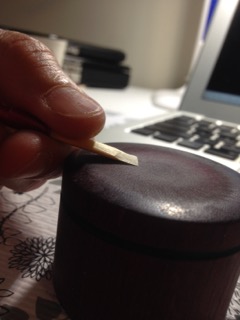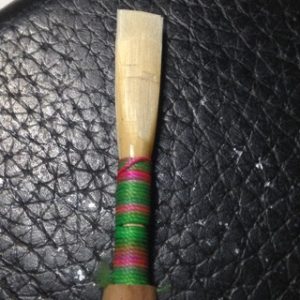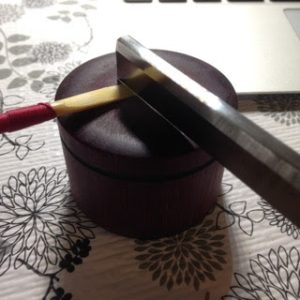 When I clip my reed to shorten or balance it, I always offset the clip so that the two blades are slightly different in length.
When I clip my reed to shorten or balance it, I always offset the clip so that the two blades are slightly different in length.
I do this very intentionally, because we don’t play the oboe straight away from our face
)____
)
But rather, angled downward
)
) \
\
\
So as I approach my mouth with the reed, I want the shorter blade facing towards me:
\
\ \
\ \
So that the longer back blade, or upper blade, can “catch” the air as it flies from my mouth into the oboe, and funnel it down into the instrument
===== \
\ \\ \
\ \\ \
Instead of interrupting the air and forcing it away from the oboe
====] \
\ \
\ \
 To accomplish this, I angle the reed against the cutting block as I clip
To accomplish this, I angle the reed against the cutting block as I clip
which forces the blades to offset, so I can clip straight down and wind up with an appropriately uneven result.
Occasionally, to make the articulation a little zingier, I will clip straight, and try to minimize that difference between the blades.
But I seldom find that result to be perfectly pleasant. It may solve the immediate articulation problem, which may be the thing I needed, but in my experience this technique sacrifices depth and warmth in the tone.
My close up photos might make it seem like there’s a BIG OBVIOUS DIFFERENCE between the blades, but sometimes I have to hold them up really close and squint to figure out which side goes on my lower lip and which on my upper.
 To solve that I always choose the side of the reed with the “crossover” in the thread to be the lower blade. This gives me a visual and tactile clue as to which way to play the reed. I can plop it in without looking and know that I’m doing it right – which in turn makes it really look like I know what I’m doing. It makes me appear unfussy.
To solve that I always choose the side of the reed with the “crossover” in the thread to be the lower blade. This gives me a visual and tactile clue as to which way to play the reed. I can plop it in without looking and know that I’m doing it right – which in turn makes it really look like I know what I’m doing. It makes me appear unfussy.
Has this been useful or interesting? I’ve made a PDF of it – for your reference, or for your students. You can download it HERE!

Comments are closed.